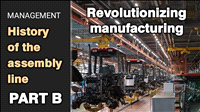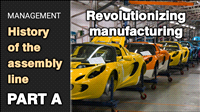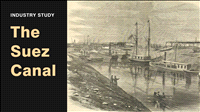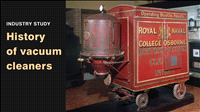The History of planned obsolescence | Industry Study
By Kiron Kasbekar | 24 Jan 2023
Today’s video is a brief discussion on the subject of planned obsolescence.
What is that?
What is obsolescence? It is the process of becoming obsolete or outdated and no longer useful. I am sure you know what the word 'obsolete' means - it means old, outdated, dated, defunct, dead, expired, extinct ... and so on. As with the word ‘obsolete’, the word ‘obsolescence’ is all about a product becoming outdated, dated, defunct, dead, expired, or extinct.
Now before we get to the heart of this issue, consider this hypothetical situation.
Imagine this. Your family members are flying in an aeroplane 10,000 feet above ground. And the engines suddenly fail. The jet turbines just crumble and fall off. The plane falls from the skies and all 400 passengers and crew plunge to their deaths.
You’d call it an accident. Right? A terrible, terrible accident.
But what if the aircraft manufacturer had designed the plane so that after flying 5,000 hours, it would stop working. And your family and all the other passengers and crew just happened to be on the flight that started in its 4,999th hour?
Would you still call it an accident?
Or would you call it something like ‘MURDER!’?
Thankfully aircraft manufacturers are not that wicked. And planes do not simply fall out of the sky and crash only because their planned obsolescence hour has finally arrived!
That’s perfectly rational, isn’t it? You cannot just make a plane in a way that it just stops working at some point of time – wherever it is, on the ground, on the point of taking off, or landing, or high up above the earth.
Airlines maintain an inventory of spare parts, and aircraft manufacturers also maintain such an inventory, and these are used to replace faulty parts in a plane.
Also, they have diagnostics to check if a part needs replacement. And if the diagnostics finds that that part is faulty, it is replaced while the aeroplane is still on the ground. The airline bosses don’t say, ‘Oh! One of the flaps on the right wing has disintegrated. Now we must scrap the aircraft!’
No! Aeroplanes last for up to 36 years! You heard that right – not months! Years!
If that is a good idea for massive aeroplanes weighing hundreds of tonnes, which get buffeted by strong winds, and which carry tonnes of passenger and cargo weight, and face huge pressures as they fly against very powerful winds, then why is it all right for your music system, TV set, laptop, mobile phone battery, or mixer-grinder to shut down all of a sudden after a certain number of months or a few years, and you are left with no option but to scrap it and buy a new one?
Let me make this clear. There is nothing wrong with companies making new devices that are better than older ones. That’s welcome.
Also, regrettable as it might be, we cannot complain that products should last forever. Everything suffers from wear and tear, and dies. That, however, is not the deliberately planned death after a certain amount of use – which is what planned obsolescence is.
I hope you liked what you’ve seen and heard so far. And I hope will subscribe to this channel – and also click on the ‘like’ button below.
Now let us proceed further.
Back in the 1920s, a little more than two decades after the first mass-produced cars rolled into the American market, it seemed like the romance with cars was coming to an end. Most Americans who could afford to buy a car had already bought them; so the hopes of selling more cars in the future began to dwindle.
That was when the much celebrated Alfred P. Sloan, chief executive of General Motors, and his team proposed a plan that would transform things, which came to be known as planned obsolescence.
At the time when GM under Sloan pushed his scheme for planned obsolescence, the company’s main rival, Ford Motor, was pushing the concept of ‘you can have any color provided it is black’.
In its early days, Ford’s Model T car was offered in a variety of colors, such as green, bright red, dark blue, maroon, brown, grey. But from 1914 to 1925, the company made only black Model T cars. Remember – I am talking only of the Model T cars, not the other models the company made.
This enabled the company to reduce costs because there was no wastage of time, materials or labor in switching from one color to another in the paint shop and assembly line. Ford passed on the cost reduction to customers by reducing prices, and the result was a surge in demand for the Ford Model T.
So how did General Motors deal with the competition from Ford Motor? The company is credited with implementing the concept of planned obsolescence – but it was not as insidious as the kind of dirty tricks companies play today.
General Motors aggressively propagated the idea that pushed people to scrap their cars even if they had used them for just a couple of years, and go and buy new cars that had some new-fangled features, like a different color, or fancier trim, or slicker seats.
So let’s make it clear here. General Motors did not deliberately cause cars to fall apart in the middle of a road. It just pushed the notion that the customer’s previous car had become boring, and that it would be a great idea to buy a new one.
What we have today is worse. Much worse. We have mobile phones that simply stop working, and you cannot even repair them; you just have to go and buy a new one.
The added incentive is that you get some so-called new features, which you could easily do without but are persuaded by all the advertising and promotional hype that they are like god’s gift waiting for you to grab!
What planned obsolescence means today is a strategy of designing a product with an artificially limited useful life or deliberately designed frailty, which makes the product obsolete after a pre-determined period of time. Obsolete not just in terms of its design and look and feel and its beginning to seem unfashionable. But obsolete in such a way that its functioning deteriorates, or the product even ceases to function altogether all of a sudden.
How does the seller benefit? With a reduction in time between repeat purchases a company generates higher long-term sales volumes. This ‘shortening the replacement cycle’, as it is called, is the deliberate shortening of a lifespan of a product to force people to purchase replacements.
Naturally, planned obsolescence works best when an industry is dominated at least by an oligopoly. After all, the producer must have a fair degree of assurance that customers would continue to buy replacements from them and not from someone else. They called it ‘brand loyalty’.
Can you imagine how warped such thinking is? Expecting brand loyalty to companies not because they make products that last, but products that do not last beyond a few years!
Obviously, such scheming fails completely when a market becomes more competitive, and the result is an increase in product lifespans. This is what happened when Japanese cars with longer lifespans entered the American market in the 1960s and 1970s. American car makers were compelled to improve the durability of their cars.
Did you know that light bulbs could have been made to last way longer than they have done without needing to be replaced?
You can read more about this conspiracy, including the companies that formed the Phoebus cartel to dupe hapless consumers into paying for unnecessary replacement of bulbs, if you visit the link given below to my business history website.
But, to continue, remember, back at the beginning of the 20th century, nearly everybody who could afford to move away from kerosene lamps began to use light bulbs! See the link below to the business history page website to see the details. If the bulbs lasted long, how would the bulb manufacturers get further revenues?
What did they do?
The cartel, which had all the biggest electric light bulb manufacturing firms in the Americas, Europe and Asia as its members, contrived to artificially reduce the lifetime of incandescent light bulbs to 1,000 hours, when technically they were capable of running for over 2,000 hours!
They actually did research to introduce a fault in the bulbs that made them die out in a thousand hours of working.
The cartel actually had a lab to test random samples from member companies’ bulbs. And that lab would test how long the bulbs lasted. If they lasted for more than a thousand hours – whoops! The company that made the bulb would have to fork out a heavy fine!
In our various videos, we have looked at the history of products, and we’ve seen how products evolve with the use of newer technologies and different materials.
For a very long time new products almost always offered better features and improved usability. And product prices plummeted with the use of new technologies and larger-scale manufacturing facilities.
But one thing that most manufacturers of the past took pride in – and that was the durability of their products. Sadly, somewhere in the past century, and especially since the end of the Second World War, manufacturers began to build in a lack of durability in their products. Deliberately.
They began to make their products in such a way that there were always at least a few components of a product that wore out or simply broke down, and the entire product would have to be scrapped and a new one purchased in its place.
In the developed countries, given their high labour costs, buying a new product usually worked out cheaper than getting it repaired. In places like India and other developing countries users could usually get spare parts and get repairs done.
But that has changed, and now products tend to get junked here too.
I have seen some of the best known consumer electronics products being thrown away within two or three years of use. I remember, back in the 1960s and 1970s, when I was in college and a bit later, our TV sets lasted years and years, often without any repairs being required. That applied to music systems, and to cameras, and various domestic appliances.
That’s no longer true.
Today gadgets stop working properly after barely a couple of years of use, and then just conk out. I have had some of the best branded fitness bands dying out on me in just a year and a half or two. And then discovering I cannot get them repaired.
In other cases, the cost of repair is so high that you may as well junk whatever it is you want repaired, and go for a brand new buy.
Why?
Because the manufacturers want to make fatter profits!
The way I look at it, there are two major reasons why planned obsolescence is bad.
I don’t care if companies make more profits. Good luck to them! But I do care if people are made to purchase new gadgets when the old ones could have been just fine had it not been for companies’ greed causing them to abort. Not everybody has piles of money saved to buy more and more of the same things with minor tweaks.
But then there is this argument: ‘Consumers want change; they get tired of using the same gadgets day in and day out.’
Really? If you really wish to give consumers the choice, why can’t you just let products last as long as modern technology allows them? Let those who don’t mind getting bored seeing the same TV set or music system year after year do as they wish.
That doesn’t stop those who wish to change things every year or two from doing so. They can always pass on their used gadgets to someone else who might not have been able to afford them earlier, and buy a new one for themselves.
Oh, but the cost! If any company argues that a longer lasting product would cost more, all I can say is – RUBBISH! When you throw away a music system or a mixer-grinder, it’s because some not-so-expensive part has broken. And it has broken because it was designed to break!
Then there is the ecological issue. The pace at which people are using up and destroying the earth’s resources, you’d think that there is another earth waiting for all of us to migrate to, not too far away. Another planet waiting to be ravaged and destroyed.
But there isn’t such a world nearby. And even if there were, it would be impossible for more than a handful of ultra-rich people to migrate there. For the rest of us, the earth is the only place in the universe where we can survive.
I am not done with talking on this subject. The issue of planned obsolescence is not something that is going to go away anytime soon. And I’ll tell you why. It’s because the culprits are big companies with great clout and the means to find technical as well as legal ways around restrictions.
Their only concern is to increase their profits – how their tactics damage their customers, damage the environment or dangerously deplete the earth’s resources is not on their agenda. They may also publish social responsibility reports year after year, but they will not allow the interests of society to come in the way of their profits.




























